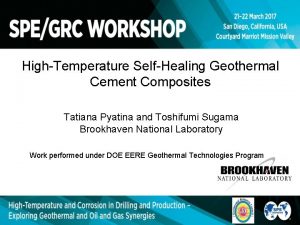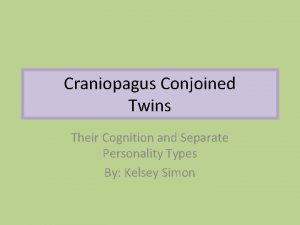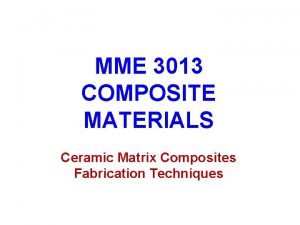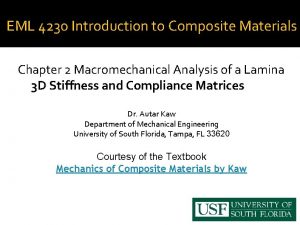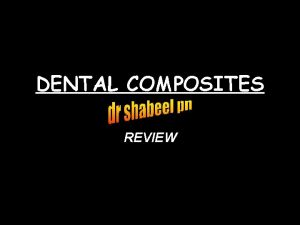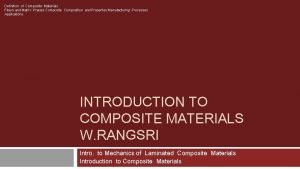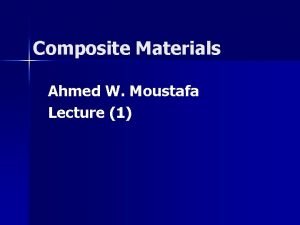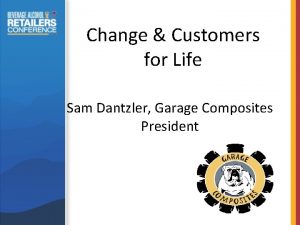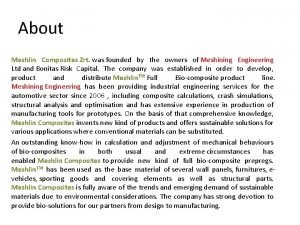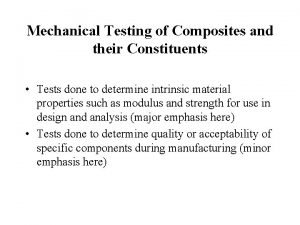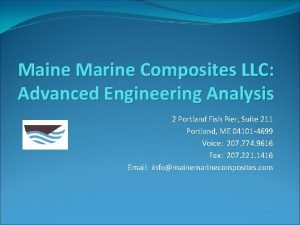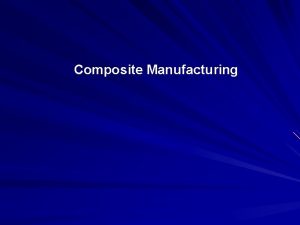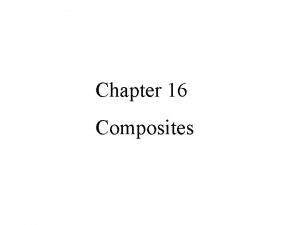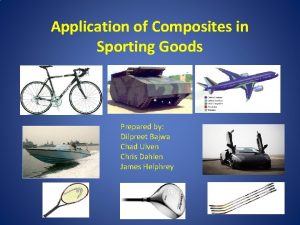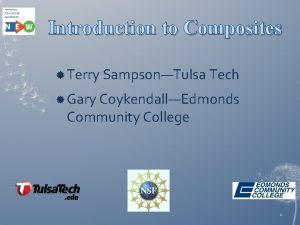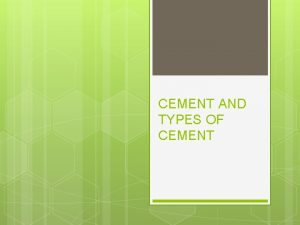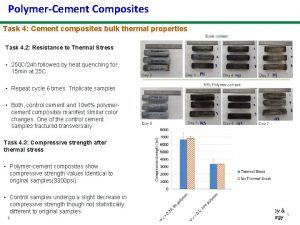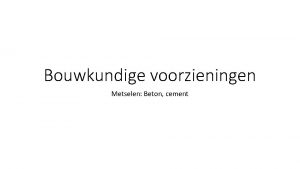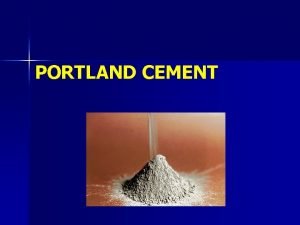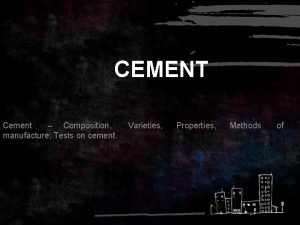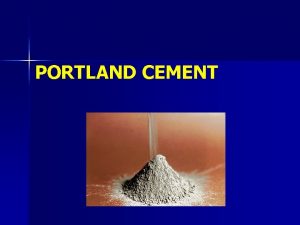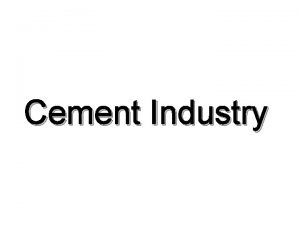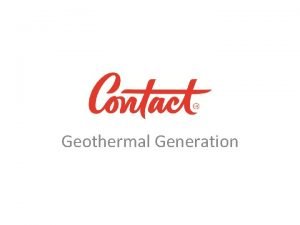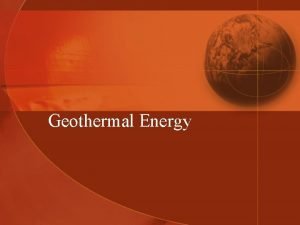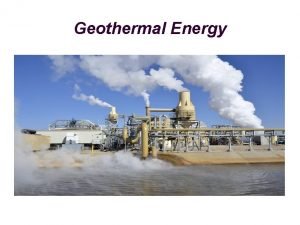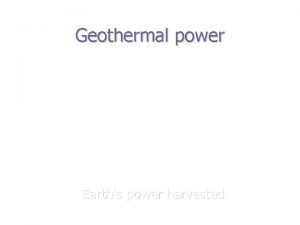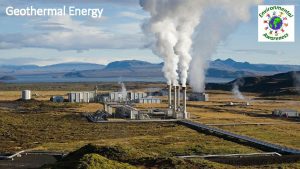HighTemperature SelfHealing Geothermal Cement Composites Tatiana Pyatina and















- Slides: 15

High-Temperature Self-Healing Geothermal Cement Composites Tatiana Pyatina and Toshifumi Sugama Brookhaven National Laboratory Work performed under DOE EERE Geothermal Technologies Program

Objectives and approach High temperatures and aggressive environments (at up to 300 o. C): self-healing requirements Approach and test methods Controlled damage Strength recovery Fractures and cracks sealing Bonding recovery Bad Compressive and bond strengths before and after the damage Good Optical microscope for sealing, analytical technics for phase identification

Self-healing cementitious materials Cement binders Calcium aluminate cement (CAC) Ordinary Portland cement (OPC) Zeolite Silica Ferrierite (Ferr, zeolite 2) Clinoptilolite (Clin, zeolite 1) Natural Cementitious systems Clays Pozzolan Industrial byproducts Fly ash F (FAF) and C (FAC) Ground granulated blast furnace slag (GBFS) Metakaoline Bentonite Montomorillonite E-type Micro Glass Fiber (MGF) Additives Retarder Alkali or phosphate activator 3

Matrix strength recovery (5 days of healing): A+>100%; A 80 -99%; B 60 -79%; C<60% (10% CMF in all formulations) Cement system Curing Environment (270 o. C and 350 o. C) Water Alkali Carbonate Hypersaline brine Thermal shock (350 o. C-25 o. C) Class G/Si. O 2 C B B A CAC (#80)/FAF* A A+ CAC(#80)/Zeolite 1 A A A+ A+ Class G/Si. O 2/Zeolite 1 C A C N/A OPC/Zeolite 2/Si. O 2** A+ A C A+ CAP/FAF C C A A+ GBFS/FAC B B B A GBFS/FAC/Zeolite 1 A A FAC/FAF C B C A * - Thermal Shock Resistant Cement (TSRC) ** - Flex. Cem

Lap shear bond testing Lap shear bond strength (left) and tensile bond extension (right) for six cements adhering to CS after exposure for 1 day to 300°C water or alkali carbonate environments. Visual observation to identify the bond failure modes and CS’s corrosions for samples after exposure in water: Cohesive and mixed failures (left) and adhesive failure (right).

Self-adhering behavior of TSRC with micro-glass fiber (MGF) at 300 o. C. water brine CO 2

Self-adhering behaviors of very high strength Slag/Si. O 2 cement with MGF at 300 o. C water CO 2 brine

Universal healing aid – micro glass fibers (MGF) Matrix strength recovery: A+>100%; A 80 -99%; B 60 -79%; C<60% Cement system Curing Environment (300 o. C) Water Alkali Carbonate Hypersaline brine Formulations with Micro Glass Fibers (MGF) Class G/Si. O 2/MGF A A A CAC (#80)/FAF/MGF A+ A+ A+ CAC(Fondu)/FAF/MGF A+ A+ A+ Ca. P/FAF** C B A FAC/FAF/MGF C C B GBFS/Si. O 2/MGF A A+ B Lap Shear Bond strength/Bond extension, psi/% Class G/Si. O 2/MGF 52/1. 43 30/1. 3 74/1. 75 CAC (#80)/FAF/MGF 237/2. 81 347/4. 47 260/3. 51 4/1. 22 35/1. 44 6/0. 98 Ca. P/FAF 196/2. 37 125/1. 49 106/1. 5 FAC/FAF/MGF 189/2. 17 228/2. 64 15/1. 28 GBFS/Si. O 2/MGF 345/4. 22 254/3. 33 98/1. 35 CAC(Fondu)/FAF/MGF* *- slow-set system; ** - brittle cement

Brittle cement in thermal shock tests - after heating to 350 o. C Before test GBFS/Si. O 2/MGF After heating to 350 o. C

Tough cement in thermal shock tests - 6 cycles of heating to 350 o. C – 25 o. C water cooling Before test After test Developed hair cracks Thermal shock resistant cement (CAC(#80)/FAF/SMS) with GMF

Effect of retarder on strength recovery and cracks sealing – 1% Tartaric Acid No TA Before healing Water After healing TA TA No TA Carbonate Before healing After healing Si Ca Water Carbonate Si Ca

Phases participating in self-healing • • • Crystalline phases: – Matrix strength recovery – Calcium aluminum silicates (feldspars); sodium aluminum silicates (zeolites); calcium silicate (TA); carbonated calcium-aluminum-silicate (in carbonate environment); magnesium (calcium) silicates (in brine) – Cracks – Zeolites; calcium-aluminum silicates (feldspar and Ca-containing mica type) Amorphous phases: – Sodium(calcium)-aluminum-silicate hydrate Effect of GMF: – Increased crystallinity at short curing times; Mg-containing silicates in all environments – improved strength recovery (fast MGF reaction) Water

Summary: • Cementitious materials can be formulated to have self-healing properties allowing strength recovery and cracks sealing at temperatures up to 300 o. C (inorganic matrix) • CAC/FAF/SMS blend (TSRC) showed the best performance among tested materials • Strength recovery and cracks sealing maybe further improved with additives such as Micro Glass Fibers and set retarder (TA) • MGF are most appropriate formulations with high amorphous phase content Future directions: • Self healing behavior after long-term exposure tests (steam, alkali carbonate and geothermal brine) • Phase identification of healing reaction products • Healing behavior after long term exposures to sc CO 2/brine and p. H 1 H 2 SO 4/brine of cement matrix and cement-casing bonding

Thermal shock Resistance and Bond Strength Crystalline phases: Zeolites – Sodalite Cancrinite Analcime Thomsonite CAC/FAF/SMS Carbonation resistance Before healing After healing Stable Crystalline phase: Carbonated sodalite Sodium Cancrinite H 0. 88 Na 8 Al 6(Si. O 4)6(CO 3)1. 44(H 2 O)2 Before CO 2 OPC/Si. O 2 Strength recovery and fractures sealing water 1865 psi 2150 psi CO 2 CAC/FAF/SMS After CO 2 1780 psi 2504 psi brine Lap Shear Bond Strength Acid resistance CAC/FAF/SMS Stable Crystalline phase: Alunite Amorphous phase: Aluminum silicate Before CAP OPC/Si. O 2 Cements formulations 1510 psi CAC/FAF/SMS 2925 psi Sealing After

Questions?
 Tatiana pyatina
Tatiana pyatina Ofsted components and composites
Ofsted components and composites Trishna and krishna
Trishna and krishna Ceramic matrix composites definition
Ceramic matrix composites definition Monoclinic material stiffness matrix
Monoclinic material stiffness matrix Composite definition chemistry
Composite definition chemistry Matrix phase meaning
Matrix phase meaning Ceramic matrix composites definition
Ceramic matrix composites definition Sam dantzler
Sam dantzler Meshlin
Meshlin Astm d7332
Astm d7332 Maine marine composites
Maine marine composites Advantages and disadvantages of thermoplastics
Advantages and disadvantages of thermoplastics Matrix materials zrt
Matrix materials zrt Composites in sports
Composites in sports Warp clock composites
Warp clock composites
